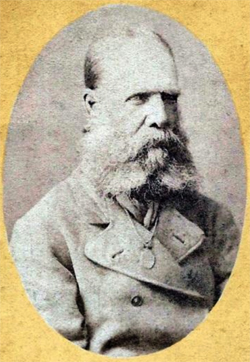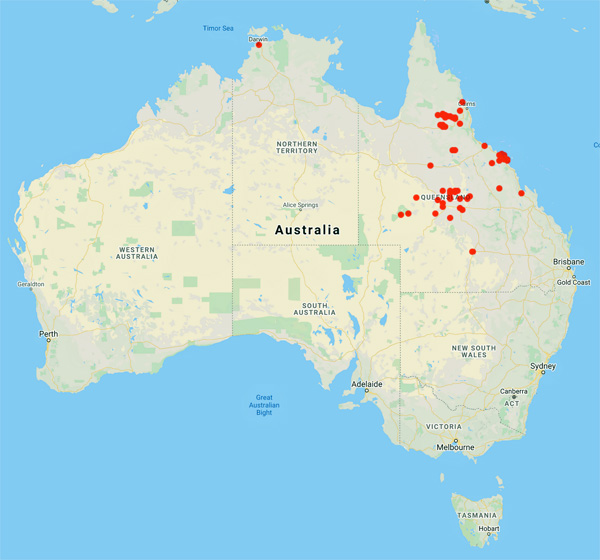
Council of Heads of Australasian Herbaria
Australian National Herbarium
Biographical Notes
 |
Council of Heads of Australasian Herbaria |
 Birch, Charles Weldon (1821 - 1894)
Birch, Charles Weldon (1821 - 1894)
aka: de Burgh, Charles Weldon (Count Zelling)
Born on 25 June 1821 in Camberwell, England;
Charles Weldon Birch was an amateur botanical and zoological collector active in central and north-eastern Queensland 1852-93. He was the embodiment of the wandering naturalist, but as with most amateur collectors he remained on the fringe of ‘official’ science.
In 1828 his father Augustus Birch was assigned to the Colony of New South Wales (War Office 1830, 1834), and the family moved to Sydney, arriving on the Governor Ready, 16 January 1829. The Birch sons, Gustavus, Charles and John, were aged nine, eight and five years, and two of the three daughters, Rosa and Charlotte, aged four and three years respectively when the family arrived in Sydney.
From the available evidence, Charles was educated to the age of fifteen, and though the family was not wealthy, they mixed within the political and administrative society of colonial New South Wales.
Birch acquired land at Mudgee, in present-day central New South Wales, in 1841, and was employed there as a Clerk in the Surveyor General's Office. On 1 April 1852, he commenced as Assistant to the Geological Surveyor Samuel Stutchbury, a position he held until 30 November 1855.
Birch, at age 31, was first engaged in field work during Stutchbury’s sixth geological survey, which covered the area from Mudgee to Talbragar River, in 1852. Receiving only a minimal wage, Birch had to employ, at his own expense, workers who helped with the geological surveys.
in 1861, he obtained a licence for a pastoral property (a run) in Queensland at Warrego South, and moved to the Maranoa area. He lived in Queensland for the rest of his life but seemed unable to maintain the various pastoral licences for very long.
Birch's first documented zoological collections were land and freshwater shells collected in 1857 at the Namoi River. He went on to collect freshwater invertebrates, fishes, insects, gastropods and later reptiles, a total of at least 60 specimens which were mainly sent to the Australian Museum and later the Queensland Museum.
His first documented botanical collection, a Nymphaea sp. from Thomson River, was made in 1870, and was collected with the encouragement of Baron Ferdinand von Mueller. About 760 botanical specimens collected by Birch are extant, most of which are in the Herbarium of the Royal Botanic Gardens Melbourne.
In 1870, Birch became involved in the search for the lost explorer Ludwig Leichhardt, and was commissioned by the Ladies’ Search Committee to undertake an expedition to investigate a possible survivor of Leichhardt’s missing party living in the Thomson/Diamantina Rivers area, QLD. The search revealed no positive evidence of Leichhardt or his party.
Birch took on additional names which he related to his ancestry, ‘de Burgh’ in 1871 and ‘Count Zelling’ in 1874, and which he used in official documents, written works and specimen labels.
Birch's health began to fail in 1893, although he maintained a keen interest in the natural world. Approaching his seventy-third year, he died on 5 June 1894 in the Walsh District Hospital at Montalbion, QLD, with his death certificate noting the cause of death as ‘1.Senile degeneration 2.Apoplexy 3.Exhaustion’. 90 He was buried at Montalbion Cemetery in an unmarked grave.
Based on specimens that he collected, Birch is commemorated in three animal taxa and one plant taxon, the Galvanised Burr, Sclerolaena birchii. Including the above eponymous taxa, Birch collected the type specimens of bryophytes (2 taxa), lichens (2), angiosperms (14), gastropods (1), branchiopod crustaceans (1), insects (1) and reptiles (5).
A detailed account of the life of Charles Birch is available in the North Queensland Naturalist 46 (2016) p.16-46: Dowe, John Leslie (2016) 'Charles Weldon (de Burgh) Birch (Count Zelling), an unassuming botanical and zoological collector in central and north-eastern Queensland' [PDF-link]
Source: Extracted from: Dowe, John Leslie (2016) North Queensland Naturalist 46 (2016) p.16-46
Portrait Photo: Extracted from: North Queensland Naturalist 46 (2016) p.18.
Data from 722 specimens
